

- Basque country -
even the Parking Wardens and Town Police wear the Red Beret of Basque Nationalists and road signs, as well as many shop signs, are in the Basque language which is pretty impenetrable but with Spanish translations underneath - a bit like Wales I suppose.
Its a bit of a walk to the old
fisherman's town, about 10 minutes but once there its full of shops, restaurants
and small supermarkets. Interesting architecture
which is very different from neighbouring France and at the
Interesting architecture
which is very different from neighbouring France and at the
 far end
of the town an excellent small tourist office. Just
beyond the town is the 'Old Town' - a bit of a walk but very well worth it.
The old castle at the top has been converted into a Parador Hotel - A chain of
state owned luxury hotels and the walk though the cobbled streets is delightful.
Dominating the town from its highest point, the Parador rises up in the
beautiful Plaza de Armas next to the Nuestra Señora del Manzano church, in the
old quarter of one of the most stately towns of the Basque Country. Hondarribia
(formerly Fuenterrabia) - all a bit like something out of Kiss me Kate!
Worth going into the lobby and there are nice bars on the other side of the
square for sitting out drinking cold beer, coffee or chocolate.
far end
of the town an excellent small tourist office. Just
beyond the town is the 'Old Town' - a bit of a walk but very well worth it.
The old castle at the top has been converted into a Parador Hotel - A chain of
state owned luxury hotels and the walk though the cobbled streets is delightful.
Dominating the town from its highest point, the Parador rises up in the
beautiful Plaza de Armas next to the Nuestra Señora del Manzano church, in the
old quarter of one of the most stately towns of the Basque Country. Hondarribia
(formerly Fuenterrabia) - all a bit like something out of Kiss me Kate!
Worth going into the lobby and there are nice bars on the other side of the
square for sitting out drinking cold beer, coffee or chocolate.
 Just
a couple of hours sail down the coast is the idyllic town bay of St Sebastian
which sadly, except in winter, is never an empty anchorage as shown in the
picture on the right! The entrance which looks so clear and calm, is
apparently is full of white water and unusable in gales. Once inside to
the east (left just past the aquarium) is the little fishing harbour and the
yacht club with moorings laid everywhere. To the west, behind the island, are
more moorings with the possibility of finding a place to anchor, except it is
then a long dinghy ride to the little fishing harbour and the dinghy pontoon.
Smaller yachts may be able to enter the little harbour and find a space on the
pontoons or possibly pick up a buoy if it is vacant and then check with the
'club'.
Just
a couple of hours sail down the coast is the idyllic town bay of St Sebastian
which sadly, except in winter, is never an empty anchorage as shown in the
picture on the right! The entrance which looks so clear and calm, is
apparently is full of white water and unusable in gales. Once inside to
the east (left just past the aquarium) is the little fishing harbour and the
yacht club with moorings laid everywhere. To the west, behind the island, are
more moorings with the possibility of finding a place to anchor, except it is
then a long dinghy ride to the little fishing harbour and the dinghy pontoon.
Smaller yachts may be able to enter the little harbour and find a space on the
pontoons or possibly pick up a buoy if it is vacant and then check with the
'club'.
I finding it very difficult to get the 'pick' to dig into the hard packed sand near to the fishing harbour which, I suspect, has rock underneath when we were shown to a mooring buoy beside the fishing harbour, by the 'club' boat and we took the dinghy to the visitors pontoon, tied up and spent the day site seeing.
In the past I have successfully anchored behind the island but swinging room, with all the laid moorings around, is also a bit of a challenge. If you visit allow yourself the time to get to the next port in case it is impossible to find a berth for the night. Having said all that it is really worth a seeing St Sebastian. It is the summer capital of Spain. From June to September, the population swells as droves of Spanish bureaucrats head to this elegant resort to escape the heat. It is a bustling city with a population of 185,000 inhabitants, some 16,500 of whom are university students, being the cultural capital of the Basque country as well. There are some lovely little shopping streets and big squares to enjoy a quiet drink in the shade. Good shops and of course all the facilities of a major beach resort.
 The
next morning we headed out of the bay for a pleasant sail westwards to Guetaria
which can be entered at any state of the tide. Basically a fishing village/town
it has a small marina just to port as you enter, with all facilities. The
town itself Getaria (Guetaria, in Spanish), is known as
la cocina de guipúzcoa, the kitchen of Guipúzcoa province, for its
many restaurants and taverns. Getaria was the birthplace of Juan Sebastián
Elcano (1460-1526), the first circumnavigator of the globe and Spain's most
emblematic naval hero. Elcano took over and completed Magellan's voyage after
the latter was killed in the Philippines in 1521. The town's galleon like
church has sloping wooden floors resembling a ship's deck. It has several
steep streets leading up to the square and one of the cafe's has a 'hot spot' so
you can enjoy a quiet drink and some tapas whilst you get online..
The
next morning we headed out of the bay for a pleasant sail westwards to Guetaria
which can be entered at any state of the tide. Basically a fishing village/town
it has a small marina just to port as you enter, with all facilities. The
town itself Getaria (Guetaria, in Spanish), is known as
la cocina de guipúzcoa, the kitchen of Guipúzcoa province, for its
many restaurants and taverns. Getaria was the birthplace of Juan Sebastián
Elcano (1460-1526), the first circumnavigator of the globe and Spain's most
emblematic naval hero. Elcano took over and completed Magellan's voyage after
the latter was killed in the Philippines in 1521. The town's galleon like
church has sloping wooden floors resembling a ship's deck. It has several
steep streets leading up to the square and one of the cafe's has a 'hot spot' so
you can enjoy a quiet drink and some tapas whilst you get online..
I really liked the place and was saddened when the marina manager said we had to leave as he had a fleet of boats from a 'rally' booked to come in and we would be in the way...
For my sailing books and French canal guides please go to
French Canal Routes to the Mediterranean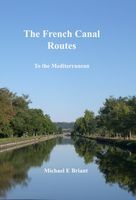
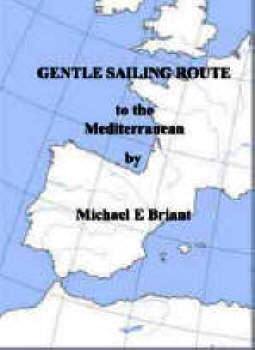

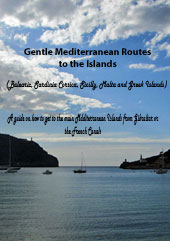
Gentle Sailing Route to the Mediterranean
Gentle Mediterranean Routes to the Islands
Caribbean Islands Cruising Guides
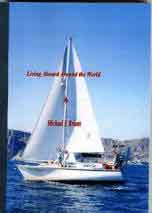
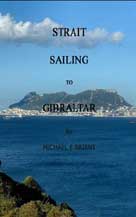
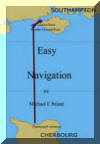
Living Aboard Around the World
'Not a big problem as next
door is Zumaia with a new marina and they have plenty of space always' -
space always' -
The forecast was not good with a northerly F6-7 due in after 12 hours. I looked at my chart and decided I did not want to try Zumaia except an hour or so either side of high water, so decided to head onto Montrico which this years French Pilot Book reported as having already commenced building a new marina.... Mmmm...
It was late in the afternoon when we sailed in past a new wall being built out of the cliff then an outer breakwater and through what felt like a very small gap into the inner harbour with not a sign of a pontoon or a marina at all - in fact just a more crowded version of the picture to the right!
A fishing boat skipper indicated we should tie up against the wall and I went ashore to find the port captain to hopefully pick up a buoy in harbour.. He was really friendly but said with the bad weather coming in for the next few days they would probably all be wanted by their owners but I was welcome to lay against the wall beside the smart stainless ladder. He said he suspected we would be there for at least 3 nights until the 'blow' finished.
 Back
aboard the books came out as I worked out the tidal range which appeared to be
around 6 metres so then a load of ropes were sent ashore as we practised the art
of 'loose moorings'. Despite my total confidence in my mathematical
ability I turned out towards low water to make sure we were not being hung up
from the cleats. All the fenders were out on the wall side which was a
good thing as despite the very narrow slightly overlapping entrance a surge
entered the harbour and made the night uncomfortable. The next day was
spent exploring the town and keeping an eye on the tide... A pleasant
enough place with some nice little bars and restaurants but with the worry at high water
of having vast amounts of rope between my boat and the quay and
at low water surging against the 'pads' designed to keep steel ocean going
fishing boats off the wall it was not easy to relax and I decided that the
following morning we would leave for Bilbao - come hell or high water.....
Which is what we did!
Back
aboard the books came out as I worked out the tidal range which appeared to be
around 6 metres so then a load of ropes were sent ashore as we practised the art
of 'loose moorings'. Despite my total confidence in my mathematical
ability I turned out towards low water to make sure we were not being hung up
from the cleats. All the fenders were out on the wall side which was a
good thing as despite the very narrow slightly overlapping entrance a surge
entered the harbour and made the night uncomfortable. The next day was
spent exploring the town and keeping an eye on the tide... A pleasant
enough place with some nice little bars and restaurants but with the worry at high water
of having vast amounts of rope between my boat and the quay and
at low water surging against the 'pads' designed to keep steel ocean going
fishing boats off the wall it was not easy to relax and I decided that the
following morning we would leave for Bilbao - come hell or high water.....
Which is what we did!

An excellent 50 odd mile sail going really well. The headlands had some large swells coming into them so care was needed and as always when you depart, with front having gone through, the wind dropped all day and by afternoon we were motor-sailing our way into that huge and very secure port which is Bilbao and finding ourselves a berth in the friendly and welcoming Yacht Club of Marina Club Maritimo del Abra at Las Arenas. Unlike many Spanish Yacht clubs it positively encourages visitors and it has made shower facilities available just across the road from the marina in the main elegant club house. You are welcome in the little club house beside the marina to use their facilities when they are open but there is a dress code for eating and drinking beside the swimming pool and particularly in the main club house which is quite smart. Interestingly the 40€ a night fee plus extras for 'live aboard' reduced to 200€ all in for a two week stay.
Bilbao is actually inland several miles up the river with low bridges in the vicinity of the town. It is therefore some miles from the town of La Arenas which has a wide range of good quality shops and grocery stores. There are a couple of bars who serve excellent tapas which makes lunch really easy, economic and delicious as well as having 'hot spots' for the internet.
The 'metro' local train service
runs into Bilbao every few minutes and Louise and I thoroughly enjoyed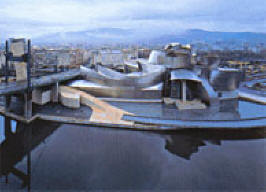 a couple
of visits to the city as well as a full half day in the Guggenheim Modern Art
gallery just across the road from the Bilbao Art Museum which is also well
endowed. We spent two
days exploring the city and enjoyed it.
a couple
of visits to the city as well as a full half day in the Guggenheim Modern Art
gallery just across the road from the Bilbao Art Museum which is also well
endowed. We spent two
days exploring the city and enjoyed it.
Various commitments meant we had to leave the boat in Bilbao for a couple of weeks whilst we returned to Saujon France by hire car which worked out quite well - although I got a Spanish speeding ticket from a hidden radar. Quite expensive!!! The Club Maritimo were very helpful and made us feel confident she would be looked after and that was indeed the case. Robert re-joined Roger in their La Rochelle home then they left for England by air!
On our return to Las Arenas, Louise and I encountered 3 boats that we had been friendly with in La Rochelle - in fact it looked like the Brits were taking over the small marina.. The winds had gone westerly and the prevailing current also headed east so we decided to start our return by heading for the port of Zumia where the tide would be towards high water at the end of the 50 mile sail. We paid the modest bill and set out a couple of days later. Lovely sail all the way and arrived more or less at HW more by luck than judgement. Looking at my depth meter and referring to the tide tables there does appear to be more water in the entrance canal than charted but with a 2 metre draft like ours I would not attempt it at more than the average half tide... but then I am very cautious..
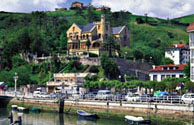 The
chart plotter or Charts of the World, really do help find the entrance which is
in the corner of a headland. The entrance has been
canalised but you have to make a sharp turn to starboard to enter the second
canal which certainly stops the surge we encountered elsewhere.. The town
is off to the right and a sharp turn to port brings you into the artificial lake
area of the marina whilst the main river continues on under the bridges. As with
so many marinas we had to go to reception pontoon, tie up and go to the office
to be allocated a berth rather than have this done on the VHF. The 'marinaro'
was friendly and helpful and we were soon comfortably established in the
charming little marina.
Zumaia is located on the coast of Guipúzcoa, at the point where
the Urola and Narrondo rivers come together. The origins of this town can be
traced to its ancient monastery. In the Middle Ages, the people that lived in
the Sehatz valley, sick of enduring the continuous attacks of pirates and
pillagers, fortified the city. That is why its church has a defensive
appearance. There are good shops and some charming little alleys and
passageways.
The
chart plotter or Charts of the World, really do help find the entrance which is
in the corner of a headland. The entrance has been
canalised but you have to make a sharp turn to starboard to enter the second
canal which certainly stops the surge we encountered elsewhere.. The town
is off to the right and a sharp turn to port brings you into the artificial lake
area of the marina whilst the main river continues on under the bridges. As with
so many marinas we had to go to reception pontoon, tie up and go to the office
to be allocated a berth rather than have this done on the VHF. The 'marinaro'
was friendly and helpful and we were soon comfortably established in the
charming little marina.
Zumaia is located on the coast of Guipúzcoa, at the point where
the Urola and Narrondo rivers come together. The origins of this town can be
traced to its ancient monastery. In the Middle Ages, the people that lived in
the Sehatz valley, sick of enduring the continuous attacks of pirates and
pillagers, fortified the city. That is why its church has a defensive
appearance. There are good shops and some charming little alleys and
passageways.
There is a walk of about 10 minutes across the pedestrian bridge to the town but the nicest, best value restaurant, we found was actually within the marina complex. The onset of further bad weather gave us and extra couple of days here, which we thoroughly enjoyed in the lively town that has great tapas bars and a good atmosphere.
Now somewhat delayed in our return trip we headed out across the corner of the bay to Bayonne in France which seemed to be the least tidal of the French ports in the South East corner of Biscay. In fact the marina is at Port d'Anglet - about a kilometre up the river just opposite the zone portuaire where the yellow road touches the river.....
It was clearly accessible, except perhaps on the ebb tide when the current flows out at 5- 6 knots or more at big springs.... The pilot book also warns of surf in the entrance, over the bar in onshore winds over tide... this video shows the surf beside the entrance on a pretty calm day... Not sure I would use it as the first stop from La Rochelle or Royan although friends of ours have, very successfully. The early breakwater shot is of the pier to the north of the entrance and you can see ships anchored off waiting for the tide.... and a pilot... the rest is lots of surfers - about 100 metres from the entrance
I think it is not a 'port of refuge' in anything of a blow...We timed the short passage to arrive just after low water and this was somewhat too early.. 3 hours before before HW would probably have been better but none the less, under motor power, we headed up the Adour river at a good 5-6 knots making perhaps 1-2 over the ground and taking avoiding action to miss the marker buoys of the drift nets that are set by the local fishermen 3/4 of the way across the river... It is important to keep to Starboard leaving the white marker buoys of the drift nets to port. What happens is the fishing boats - small launches - lay nets with the outside end on a large white buoy across the river some 2-300 metres above the marina entrance. Having dropped the net close to the south edge of the river they back off as close as possible to the North side then 'drift' with the current. Apparently they are supposed to leave enough space for boats to pass up or down stream on the south side... ' Supposed!' Still the south side is deep up to the shore line...Quite interesting! I radioed ahead to the marina control office and they asked me to call again when I was 5 minutes away. Off to port is a big industrial area with large coasters tied up charging and discharging cargo. It is noticeable that much of France, on the Atlantic coast, has considerable small ship activity all helping to keep large lorries off the roads
I called up again on the VHF and was told there would be somebody on a pontoon to help us. We eventually came up to the narrow gap that had been created for the entrance to the marina and stemming the tide entered. It is not big and with some strong currents running I was please to see a couple of marina staff on a pontoon waiting to take our lines. With the current running strongly and not having a good angle on the berthing place I went astern and backed out into the river again, set up the lines and fenders and made a more direct approach to the berthing spot, which worked our fine as we were being pushed on by the not inconsiderable tide... Even if you French is not good it is probably worth making a call on Ch 9 to the office in case the visitors pontoon right in front of the office is occupied.
 BAYONNE
is in fact some 5 or 6 kilometres from the marina
BAYONNE
is in fact some 5 or 6 kilometres from the marina but there is a regular bus service
from just behind the marina. The local area has a few
small restaurants and bars but the little local supermarket is a 15 minute walk.
Bayonne stands back some 6km from the Atlantic, a position
that until recently protected it from any real exploitation by tourism. It
bestrides the confluence of the River Adour, which rises to the east in the
region of the Pic du Midi de Bigorre, and the much smaller Nive, whose source is
the Basque Pyrenees above St-Jean-Pied-de-Port. Although purists dispute
whether it's truly a Basque there seems no doubt about its Basque flavour, with
its tall timber-frame houses and woodwork painted in the peculiarly Basque tones
of green and red. For many years the Petit Bayonne quarter on the right
bank of the Nive was a hotbed of Basque nationalism, until the French government
clamped down on such dangerous tendencies
but there is a regular bus service
from just behind the marina. The local area has a few
small restaurants and bars but the little local supermarket is a 15 minute walk.
Bayonne stands back some 6km from the Atlantic, a position
that until recently protected it from any real exploitation by tourism. It
bestrides the confluence of the River Adour, which rises to the east in the
region of the Pic du Midi de Bigorre, and the much smaller Nive, whose source is
the Basque Pyrenees above St-Jean-Pied-de-Port. Although purists dispute
whether it's truly a Basque there seems no doubt about its Basque flavour, with
its tall timber-frame houses and woodwork painted in the peculiarly Basque tones
of green and red. For many years the Petit Bayonne quarter on the right
bank of the Nive was a hotbed of Basque nationalism, until the French government
clamped down on such dangerous tendencies
If you were interested in the above you might want to look at WEST COAST FRANCE which lists some of the marinas and ports we have visited.
If you want to know more about La Rochelle/Les Minimes facilities then Sailing info la Rochelle
For my sailing books and French canal guides please go to
French Canal Routes to the Mediterranean



Gentle Sailing Route to the Mediterranean
Gentle Mediterranean Routes to the Islands
Caribbean Islands Cruising Guides



Living Aboard Around the World
To live in Spain ....
You will need to open a bank account. Barclays Spain all have at least one person who speaks English.
Transferring money from the UK to your Spanish bank account or to pay for property etc can be a minefield and unnecessarily expensive. I expect there are other good ones, but over the last 15 years or so, I have found TORFX to be inexpensive, easy to use, very fast with payments and cheaper than anybody else.
The big difference with TORFX is that they guarantee there will be no charges at the receiving end. With bank transfers and indeed companies like MoneyCorp, the bank that receives the money frequently makes a substantial charge for doing this. Worse still if you pay a bill to a lawyer or individual or even your own account in your new country, you can end up with a charge at the receiving bank - so will still owe the recipient money. It is for this reason I use TORFX.
More importantly the exchange rate is displayed as per the UK money market so you can choose to buy your Euros as you see the rate rise or fall. They have very efficient staff to help you at first then afterwards you can do it all on line quickly and easily. There are no charges at the Spanish end of the operation unlike normal 'swift' transfers and the money normally arrives within 2-3 days.
It works like this:
You go to TORFX and choose either to send a fixed amount of Euro to Spain or the Euros that a fixed amount of Pounds will buy.
You do the deal with TORFX at the moment you see the best rate of exchange displayed and TORFX issues a 'note' telling you how much you now owe them.
You go to your UK bank account and make a 'normal' transfer to TORFX for no cost and that's it.... Simple huh?
TORFX tell you by email or text that they have received the funds from your UK bank and that they have sent the funds to Spain and its eta...Normally a couple of hours...
You can of course use this system for the currency of any country in the world.
|
Contents 1 – Planning the voyage 2 – South coast to Chenal du Four 3 - Chenal du Four to La Rochelle 4 - La Rochelle to Spain overview 5 - La Rochelle to Coruña 6 - Coruña to Gibraltar |
Why not take your boat to the Mediterranean next summer?
There are several ways of getting your boat to the Mediterranean. On the back of a lorry, via the French canals, four or five day’s non stop across the Bay of Biscay then down the Portuguese coast or spend the summer or two, gently coasting southwards, enjoying the harbours, cities, towns and villages of France Spain and Portugal.
This is not a pilot book, rather a passage plan and guide to the nicer places between the South Coast of the UK to the beautiful Mediterranean Sea. It can all be done in easy stages, to suit a lightly crewed boat, with perhaps only a couple of people on board who are without ‘offshore’ experience. Actually, it is a lovely way to explore a lot of delightful foreign places.
|
Specially drawn charts of:
Cherbourg to L’Aber-Wrac’h. Chenal du Four to La Rochelle La Rochelle to Spain La Rochelle to Coruña Coruna to Gibraltar + illustrations, pictures, paintings |
|
|
Ronda is where I now live and is a beautiful town up in the
mountains and about an hours drive from the sea. Wonderful place to be
in. Vejer de la Frontera is a white hill town near the entrance to the Straights of Gibraltar. Probably the most unspoilt of all the hill towns - white villages in Southern Spain Boat Import tells you how to handle the importation of your boat legally into Spain and how to avoid paying the 12% matriculation tax. Car Import tells you how to change the plates to Spanish registration, and if its a near new car how to avoid the 12% matriculation tax - How to Register gives full details of how to 'clock into' the Spanish system if you are going to become a resident Northern Spain is just that - a wonderful cruising area for yachties and far removed in every way from the 'Costa's' Banking in Spain give some helpful info on what can be expensive and complicated. With the current 'crises' it's quite a 'cash' society so you need easy and cheap transfers. |
I am pleased to say this web site is
who have been kind, helpful and understanding. I really recommend them
Click here to purchase web hosting with HOST 100